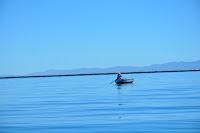(...)
We soon sailed off from Uros floating islands in what turned out to be a two hour trip to Taquille island.
A wave of extreme heat progressively set in not allowing us to stay on deck for too long. The surrounding landscape wasn't too dissimilar though and apart from the odd boat sailing along and a minor incident with some seaweed having to be removed from the propeller, the ride was uneventful.



Taquille island is 45 km offshore from Puno with its highest point being 4.050 metres, which we reached after having slowly climbed the 533 stone stairway steps.

Puerto Chilcano (left).

Taquileños are said to run their collectivism community-oriented society as in accordance with the Inca moral code "Ama sua, ama llulla, ama qhilla" (which in Quenchua stands for do not steal, do not lie, do not be lazy).
As we were making our way to the village centre we noticed several terraced farming land. Although the island's economy based on potato and corn cultivation, tourism has recently become a tourism-generated income source.
Taquille and its textile Art were not long ago proclaimed "Masterpieces of the Oral and intangible Heritage of Humanity". Throughout the Spanish colonisation and once the islanders were forbidden to use their traditional dress they adopted the Spanish peasant clothing combining it with finely made Andean-style garments and accessories (belts, ponchos, mantles, caps, coca-leaf purses, etc.), which we could clearly see are genuinely worn on their daily routine chores.





Knitting, said to be exclusively performed by males, is an Art they start at the age of eight, whilst women dedicate themselves to making yarn and weaving.
They are also said to have adapted their ancient culture to the Catholic religion, though Patchamama (the Mother Earth), the principal Andean Deity is present in almost every act.




We had a typical vegetable soup for lunch, accompanied by a small onion salad and bread with a cup of tea made fom Coca.
(to be continued)















No comments:
Post a Comment